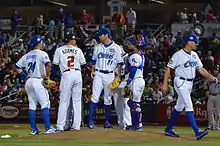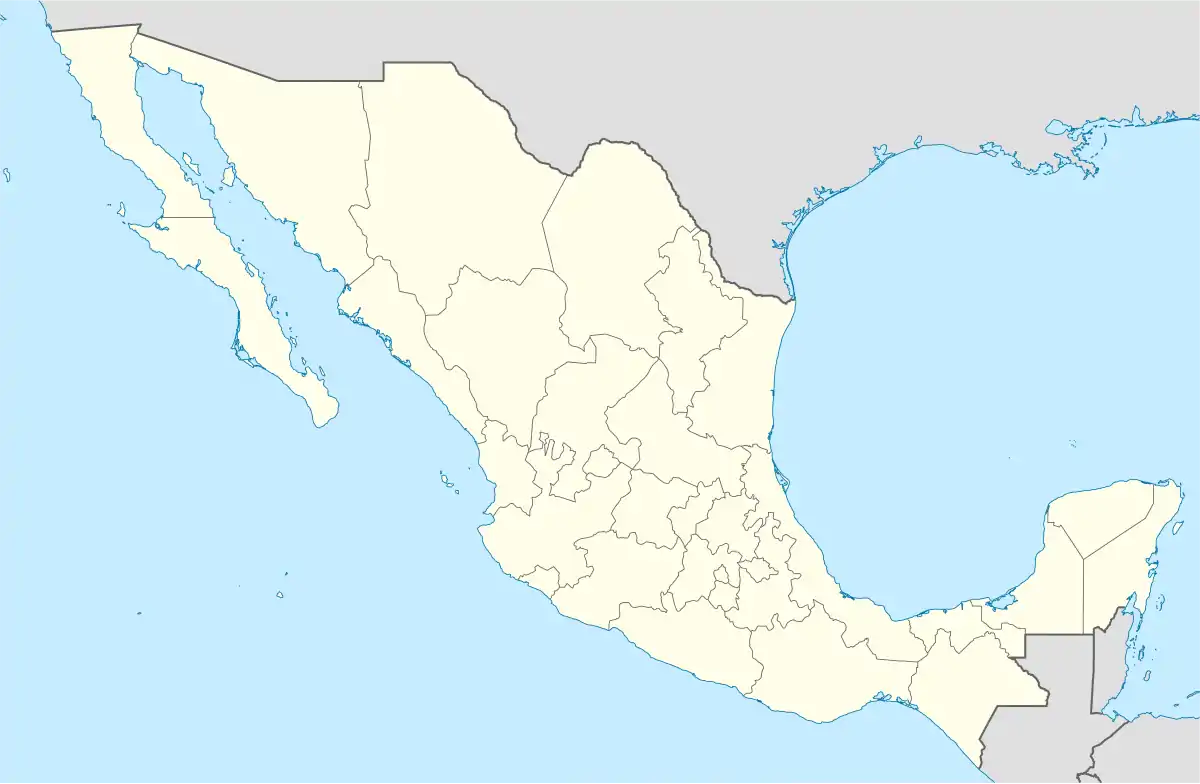Triple-A (baseball)
Triple-A or Class AAA is the highest level of play in Minor League Baseball in the United States and Mexico. Before 2008, Triple-A leagues also fielded teams in Canada.[1] A total of 30 teams play in the Triple-A International League (IL) and Pacific Coast League (PCL), with 14 teams in the IL, 14 teams in the PCL, and 2 teams to be assigned to a league before 2021. The MLB-independent Mexican League fields 16 teams. Triple-A teams are typically located in large metropolitan areas that do not have Major League Baseball teams, such as Austin, Jacksonville, Columbus, and Charlotte.

Interleague play between the International League and Pacific Coast League occurs twice each season. In July, each league's All-Star team competes in the Triple-A All-Star Game. In September each league's regular season champions play each other in the Triple-A National Championship Game to determine an overall champion of Triple-A baseball.
The Triple-A classification was created before the 1946 season. Prior to then, the top level of the minors had been designated as Double-A since 1912. The modern Double-A classification also dates to 1946, when the former Class A1 level was renamed.
Purpose
Triple-A teams' main purpose is to prepare players for the Major Leagues. ESPN wrote in 2010:[2]
Winning is nice, but secondary. It's much more important for a young prospect like outfielder Xavier Paul to get regular at-bats against lefties, or work on dropping down sacrifice bunts with a runner on first, than it is to take three of four from the Portland Beavers.[2]
Both young players and veterans play for Triple-A teams:
There are the young prospects speeding through the organization on the fastest treadmill, the guys who used to be young prospects who are in danger of topping out in Triple-A, the 30-somethings trying to get back to the majors after an injury or a rough patch, and the guys just playing a few more seasons because someone still wants them and they still want to.[2]
Players on the 40-man roster of a major league team are eligible for promotion to the major league club once the major league roster expands on September 1 (though teams will usually wait until their affiliates' playoff runs are over, should they qualify). For teams in contention for the postseason, these players create the flexibility needed to rest regular starters in late regular-season games. For those not in contention, using such players lets the teams evaluate them under game conditions.
Leagues
Teams at this level are divided into three leagues: the International League, the Pacific Coast League, and the MLB-independent Mexican League. The Mexican League fields teams throughout Mexico. The International League traditionally fielded teams in the Northeastern United States, and now fields teams in the Midwest and South as well. The Pacific Coast League originally fielded teams on the West Coast, but now fields teams throughout the western part of the United States, as far east as Nashville, Tennessee. For much of the 20th century, the American Association, which consisted of teams in the Midwestern United States, was also at this level, but it disbanded in 1997 and its teams were divided among the IL and PCL. Each of the 30 Major League Baseball teams has an affiliation with one Triple-A team in the United States. However, Mexican Triple-A teams are not included in the organized farm team system.
Current teams

International League
- Indicates IL franchise's first year in current city. Some franchises have prior history in other cities or had local predecessor franchises at other levels that shared their name.
- Many stadiums have lawn seating; thus, capacity is approximate.
Pacific Coast League
Joining Pacific Coast League in 2021
| Team | Founded | MLB Affiliation | Affiliated | City | Stadium | Capacity |
|---|---|---|---|---|---|---|
| Sugar Land Skeeters | 2012 | Houston Astros | 2021 | Sugar Land, Texas | Constellation Field | 7,500 |
To be assigned for 2021
| Team | Founded | MLB Affiliation | Affiliated | City | Stadium | Capacity |
|---|---|---|---|---|---|---|
| Jacksonville Jumbo Shrimp | 1962 | Miami Marlins | 2021 | Jacksonville, Florida | 121 Financial Park | 11,000 |
| St. Paul Saints | 1993 | Minnesota Twins | 2021 | Saint Paul, Minnesota | CHS Field | 7,210 |
Mexican League
Triple-A All-Star Game

The Triple-A All-Star Game is a single game held between the two affiliated Triple-A leagues—the International League and the Pacific Coast League. Each league fields a team composed of the top players in their respective leagues as voted on by fans, the media, and each club's field manager and general manager.[3] The event has taken place every year since 1988 when the first Triple-A All-Star Game was played in Buffalo, New York. Prior to 1998, a team of American League-affiliated Triple-A All-Stars faced off against a team of National League-affiliated Triple-A All-Stars.
Traditionally, the game has taken place on the day after the mid-summer Major League Baseball All-Star Game.[4] The game is meant to mark a symbolic halfway-point in the season (though not the mathematical halfway-point which, for most seasons, is usually one month prior). Both Triple-A leagues share a common All-Star break, with no regular-season games scheduled for two days before the All-Star Game itself. Some additional events, such as the All-Star Fan Fest and Triple-A Home Run Derby, take place each year during this break in the regular season.[5]
Triple-A Championship
Since 2006, the annual Triple-A National Championship Game has been held to serve as a single championship game between the champions of the International League and Pacific Coast League to determine an overall champion of Triple-A baseball. It was originally held annually at Chickasaw Bricktown Ballpark in Oklahoma City, and known as the Bricktown Showdown.[6] Since 2011, the game has been held in a different Triple-A city each year.[7]
Previous postseason interleague championships include the Junior World Series (1932–34, 1936–62, 1970–71, 1973–74), Triple-A World Series (1983, 1998–2000), and Triple-A Classic (1988–91).
Pace-of-play initiatives
As a part of professional baseball's pace of play initiatives implemented in 2015, 20-second pitch clocks entered use at Triple-A stadiums in 2015.[8] In 2018, the time was shortened to 15 seconds when no runners are on base. Other significant changes implemented in 2018 included beginning extra innings with a runner on second base and limiting teams to six mound visits during a nine-inning game.[9] For the 2019 season, the number of mound visits was reduced to five, and pitchers were required to face a minimum of three consecutive batters unless the side is retired or the pitcher becomes injured and is unable to continue playing.[10]
References
- Notes
- "Lynx are outta here: Team sold, will move to U.S." www.canada.com. Ottawa Citizen. April 13, 2016. Archived from the original on November 19, 2014. Retrieved September 20, 2014.
- Shelburne, Ramona (September 1, 2010). "John Lindsey waits for his chance". ESPN. Archived from the original on September 6, 2010. Retrieved September 28, 2010.
- Wild, Danny (May 30, 2014). "Voting begins for Triple-A All-Star Game". Minor League Baseball. Archived from the original on August 25, 2014. Retrieved August 19, 2014.
- "Omaha Storm Chasers and Werner Park to Host 2015 Triple-A Baseball All-Star Game". Omaha Storm Chasers. Minor League Baseball. March 5, 2014. Archived from the original on March 15, 2014. Retrieved August 19, 2014.
- "Durham Lands 2014 Triple-A ASG". Minor League Baseball. February 20, 2013. Archived from the original on March 22, 2014. Retrieved August 19, 2014.
- "Bricktown Showdown To Determine Triple-A Baseball Champion" (PDF). Triple-A Baseball. July 12, 2006. Archived (PDF) from the original on March 4, 2016. Retrieved August 17, 2014.
- Hill, Benjamin (February 8, 2011). "Isotopes to Host Triple-A Championship". Minor League Baseball. Archived from the original on August 19, 2014. Retrieved August 17, 2014.
- Jackson, Josh (January 15, 2015). "Triple-A, Double-A to Implement Pitch Clock". MILB.com. Archived from the original on April 17, 2015. Retrieved April 20, 2015.
- "MiLB announces pace-of-play rules for 2018". MILB.com. March 14, 2018. Archived from the original on March 15, 2018. Retrieved March 15, 2018.
- "MiLB announces pace-of-play rules for 2019". MILB.com. March 29, 2019. Archived from the original on March 29, 2019. Retrieved March 29, 2019.
